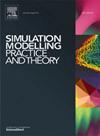曲柄滑块与曲叉机构的机械共振平衡:仿真与实验
IF 3.5
2区 计算机科学
Q2 COMPUTER SCIENCE, INTERDISCIPLINARY APPLICATIONS
引用次数: 0
摘要
滑动曲柄和斜轭机构中的不平衡惯性力、力矩和扭矩会对性能产生不利影响,导致振动、应力和加速磨损。本文提出了机械共振的应用作为一种解决方案,以减轻这些缺点。建模和研究涉及包含刚体和柔体的多体模拟,以及各种场景下的实验测试。合成部分包括对产生共振、实现最佳往复体定位和重力补偿的技术的解释。分析和比较部分检查和对比了传统和共振装置之间的输入扭矩、关节上的反作用力、振动力、振动力矩和机体内的应力。研究结果表明,在共振条件下,两种机制的动力学都得到了显著改善。在没有非保守力的情况下,滑块曲柄机构的峰值关节反力降低了79.99%,RMS值降低了76.74%,峰值惯性扭矩降低了81.6%,RMS扭矩降低了82.2%。苏格兰轭机构中的共振完全减少了由于滑块运动的谐波性质而产生的扭矩波动,从而实际上消除了主要运动副的反作用力。本文章由计算机程序翻译,如有差异,请以英文原文为准。
Balancing of slider-crank and Scotch-yoke mechanisms by the use of mechanical resonance: Simulation and experiment
Unbalanced inertia forces, moments, and torques in slider-crank and Scotch-yoke mechanisms adversely affect performance, leading to vibrations, stress, and accelerated wear. This paper presents the application of mechanical resonance as a solution to mitigate these drawbacks. The modeling and investigations involve multibody simulations incorporating both rigid and flexible bodies, alongside experimental tests in various scenarios. The synthesis section covers the explanation of techniques for generating resonance, achieving optimal reciprocating body positioning, and gravity compensation. The analysis and comparison section examines and contrasts the input torque, reaction forces on the joints, shaking forces, shaking moments, and stresses in the bodies between the conventional and resonance setups. The findings indicate significantly improved dynamics under resonance conditions for both mechanisms. In the absence of non-conservative forces, the slider-crank mechanism experiences a reduction of up to 79.99 % for peak joint reaction force, 76.74 % for the RMS value, 81.6 % for peak inertia torque, and 82.2 % for RMS torque. Resonance in the Scotch-yoke mechanism entirely reduces torque fluctuation due to the harmonic nature of slider motion, thus practically eliminating reaction forces at main kinematic pairs.
求助全文
通过发布文献求助,成功后即可免费获取论文全文。
去求助
来源期刊

Simulation Modelling Practice and Theory
工程技术-计算机:跨学科应用
CiteScore
9.80
自引率
4.80%
发文量
142
审稿时长
21 days
期刊介绍:
The journal Simulation Modelling Practice and Theory provides a forum for original, high-quality papers dealing with any aspect of systems simulation and modelling.
The journal aims at being a reference and a powerful tool to all those professionally active and/or interested in the methods and applications of simulation. Submitted papers will be peer reviewed and must significantly contribute to modelling and simulation in general or use modelling and simulation in application areas.
Paper submission is solicited on:
• theoretical aspects of modelling and simulation including formal modelling, model-checking, random number generators, sensitivity analysis, variance reduction techniques, experimental design, meta-modelling, methods and algorithms for validation and verification, selection and comparison procedures etc.;
• methodology and application of modelling and simulation in any area, including computer systems, networks, real-time and embedded systems, mobile and intelligent agents, manufacturing and transportation systems, management, engineering, biomedical engineering, economics, ecology and environment, education, transaction handling, etc.;
• simulation languages and environments including those, specific to distributed computing, grid computing, high performance computers or computer networks, etc.;
• distributed and real-time simulation, simulation interoperability;
• tools for high performance computing simulation, including dedicated architectures and parallel computing.
 求助内容:
求助内容: 应助结果提醒方式:
应助结果提醒方式:


